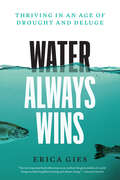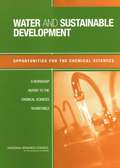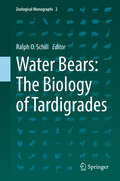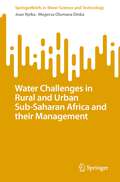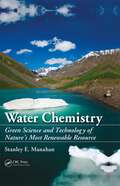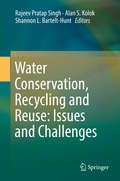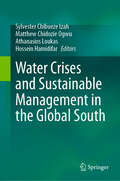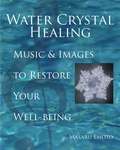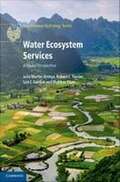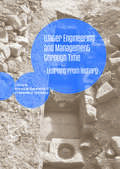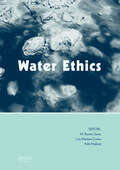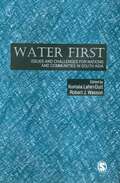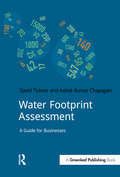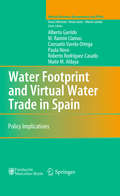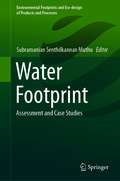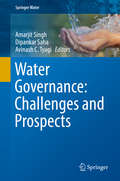- Table View
- List View
Water Always Wins: Thriving in an Age of Drought and Deluge
by Erica GiesWinner of the Rachel Carson Award for Excellence in Environmental Journalism, Water Always Wins is a hopeful journey around the world and across time, illuminating better ways to live with water. Nearly every human endeavor on the planet was conceived and constructed with a relatively stable climate in mind. But as new climate disasters remind us every day, our world is not stable—and it is changing in ways that expose the deep dysfunction of our relationship with water. Increasingly severe and frequent floods and droughts inevitably spur calls for higher levees, bigger drains, and longer aqueducts. But as we grapple with extreme weather, a hard truth is emerging: our development, including concrete infrastructure designed to control water, is actually exacerbating our problems. Because sooner or later, water always wins. In this quietly radical book, science journalist Erica Gies introduces us to innovators in what she calls the Slow Water movement who start by asking a revolutionary question: What does water want? Using close observation, historical research, and cutting-edge science, these experts in hydrology, restoration ecology, engineering, and urban planning are already transforming our relationship with water. Modern civilizations tend to speed water away, erasing its slow phases on the land. Gies reminds us that water’s true nature is to flex with the rhythms of the earth: the slow phases absorb floods, store water for droughts, and feed natural systems. Figuring out what water wants—and accommodating its desires within our human landscapes—is now a crucial survival strategy. By putting these new approaches to the test, innovators in the Slow Water movement are reshaping the future.
Water And Sustainable Development: Opportunities For The Chemical Sciences
by Chemical Sciences RoundtableExperts in the areas of water science and chemistry from the government, industry, and academic arenas discussed ways to maximize opportunities for these disciplines to work together to develop and apply simple technologies while addressing some of the world’s key water and health problems. Since global water challenges cross both scientific disciplines, the chemical sciences have the ability to be a key player in improving the lives of billions of people around the world.
Water Bears: The Biology of Tardigrades (Zoological Monographs #2)
by Ralph O. SchillOffering extensive information on tardigrades, this volume begins with a chapter on the history of tardigrades, from the first description by Goeze in 1773, until 1929, when the most comprehensive monographic approach by E. Marcus was published. Tardigrades’ organ systems, including their integument, body cavity, digestive, muscular, nervous and reproductive systems, as well as their overall external morphology, are summarized in the second chapter. Subsequent chapters present the current state of knowledge on tardigrade phylogeny, biogeography, paleontology, cytology and cytogenetics. In addition, the book provides insights into the ecology of tardigrades in marine, freshwater and terrestrial habitats. The reproduction, development and life cycles are summarized and the extraordinary environmental adaptations of encystment and cyclomorphosis, desiccation tolerance, freezing tolerance and radiation tolerance are discussed in detail. Further chapters provide an overview of key approaches in molecular tardigrade studies and describe techniques for sampling and sample processing. The book closes with a list of tardigrade taxa up to a sub-generic level, including the type species of each genus, the numbers of lower taxa in each taxon, and the main environments in which the taxa were found.Given its depth of coverage, the volume offers an invaluable resource for scientists from various disciplines who plan to research tardigrades, and for all others who are interested in these fascinating animals.
Water Challenges in Rural and Urban Sub-Saharan Africa and their Management (SpringerBriefs in Water Science and Technology)
by Joan Nyika Megersa Olumana DinkaSub-Saharan Africa grapples with many public health issues such as food insecurity, increased prevalence of infectious diseases, limited access to clean water supply, poor nutrition and lack of improved health services for its populace (IMF, 2021). Of all these challenges, the inaccessibility of clean water supply for both the rural and urban populace is the most pressing challenge, which has been exacerbated by extensive pollution and climate change crises. The issue of water access and supply affects both rural and urban populations. At rural areas water is accessed in yard taps and in arid regions through water kiosks managed by private owners. Among the urban poor, water access is compromised by poor supply infrastructure especially among informal settlers and risks such as contamination during the supply chain are imminent This book therefore seeks to close this knowledge gap by 1) generating a water resources inventory for Sub-Saharan Africa region, 2) exploring the water crises in both its urban and rural settings, 3) understanding the causatives of the crises and 4) suggesting viable solutions to manage the water challenges using named case studies. The aim is to improve understanding on the region’s water problems and advise scholars and policymakers on priority research areas and action plans to better water management for sustainable development.
Water Chemistry: Green Science and Technology of Nature's Most Renewable Resource
by Stanley E. ManahanCarefully crafted to provide a comprehensive overview of the chemistry of water in the environment, Water Chemistry: Green Science and Technology of Nature's Most Renewable Resource examines water issues within the broad framework of sustainability, an issue of increasing importance as the demands of Earth's human population threaten to overwhelm t
Water Conservation, Recycling and Reuse: Issues and Challenges
by Alan S. Kolok Rajeev Pratap Singh Shannon L. Bartelt-HuntWater - a basic element of life, livelihood, food security and sustainable development - holds the key to global sustainability. The global water demand has been increased 3-fold in the past five decades and only 0.4% of the total world’s fresh water resources is available and accessible for use. The United Nations projected that half of all countries will face water scarcity by 2025 and more than one-third of the world’s population could be affected by water stress by 2050. The water problem is rapidly intensifying in the Asian region, and around 700 million people do not have access to safe drinking water. Similarly, according to the Intergovernmental Panel on Climate Change (IPCC) report, by 2050, more than one billion people in Asia alone are projected to experience negative impacts on water resources as a result of climate change. Climate change is also putting extra pressure on and adversely affecting the global water cycle, leading to irregular precipitation, more floods and droughts and creating an imbalance between water supply and demand. The availability of safe water is a major global concern due to the rapidly increasing population, urbanization, unsustainable consumption patterns, and rapid shifts in land use. It is believed that reduced access to freshwater will have cascading consequences that will pose threat to global food security, livelihood security, and cause large scale migration and economic and geopolitical tensions. As such, strategies for water conservation, wastewater reuse and recycling should be adopted in order to lessen the gap between supply and demand for water for different activities. This book provides readers with a better understanding of the water security challenges, and presents innovations to address these challenges, strengthen the science-policy interface, and develop institutional and human capacities for water security and sustainability.
Water Contamination and Health: Integration of Exposure Assessment, Toxicology, and Risk Assessment (Environmental Science And Pollution Ser. #9)
by Rhoda G.M. WangThis volume examines every potential means of exposure to water contaminants, provides in-depth discussions on toxicology, and explains up-to-date techniques for evaluating human health risk. It develops a methodology for assessing the cumulative absorbed dose of contaminants through all routes of exposure, including ingestion, inhalation and dermal. Federal and state efforts to monitor and treat water are examined.
Water Content Estimation and Control of PEM Fuel Cell Stack and the Individual Cell in Vehicle (Springer Theses)
by Po HongThis book focuses on water content estimation and control of the PEM fuel cell stack and the individual cell in vehicle. Firstly, the mathematical connection between polarization curve and equivalent circuit model proves importance of MEA and its feasibility to study water content. Optimizing structure of MEA realizes the internal water content recirculation of a fuel cell and improves its performance under middle or lower current density. The influence of water content on performance of MEA is quantified, and variation of equivalent circuit model is an excellent indicator of water content. Secondly, the comprehensive online AC impedance measurement method is put forward, including current excitation method, weak voltage and current signal processing method, and method for analyzing measurement error, and experiment validates measurement accuracy. The high-frequency impedance and statistical characteristic are proposed as indicator of water content. Finally, the dynamic model of the air supply system of a fuel cell engine is established and the closed-loop control of the air supply system and the water content estimation are decoupled. The experiment on a fuel cell system validates the proposed method for searching optimized operating conditions and the water management strategy.
Water Crises and Sustainable Management in the Global South
by Sylvester Chibueze Izah Matthew Chidozie Ogwu Hossein Hamidifar Athanasios LoukasThis book is a reference material on how to sustainably manage water crises. The causes and effects of water crises under different regions in the Global South are explored in this book. Approaches for the sustainable management of water crises are also highlighted in the book, especially in the Global South, where the level of technologies available for sustainable management of water are limited. Water crisis is a global problem but with disproportionate higher consequences in the lobal South. About 25% of the global population resides in water-stressed countries, and about 10% of the world population lives in areas with high water vulnerability. Furthermore, many millions of people across the globe lack access to potable water supplies. As such, many people could be displaced by water crises or scarcity shortly. The effects of the water crisis on the environment include increased salinity, nutrient pollution, the loss of floodplains, the drying ofriverbeds, the loss of habitat, wetlands disappearing, and ecosystem loss. On the human level, it could lead to disease outbreaks, drought, famine, and death. This may have more severe effects in countries in the Global South as compared to nations in the Global North. This is because the water cycle is very intense in Asia and Africa, which are important areas in the Global South. This book is of interest and useful to aquatic toxicologists, water quality experts, practitioners, trainees, and trainers, environmentalists, biological sciences scientists, academics, researchers, students (especially undergraduates and postgraduates), libraries, and other public knowledge repositories interested in novel and advanced practices in sustainable water management.
Water Crystal Healing: Music and Images to Restore Your Well-Being
by Masaru EmotoFor centuries, people have turned to classical music for its calming and relaxing effects. Internationally acclaimed water researcher Dr. Masaru Emoto has discovered why certain music has healing benefits: Music with the appropriate rhythm, tempo, tone, and melody can correct distorted frequencies within our cells, assisting our health and healing. Here, you can enjoy Dr. Emoto's captivating water-crystal photographs and text in this unique collection. The possible benefits you may experience include decreased joint and back pain; improved function of the nervous, circulatory, lymphatic, and immune systems; and the release of negative emotions such as anxiety, self-pity, and depression. The combination of images and words in Water Crystal Healing concentrates consciousness as never before, providing a unique experience for healing.
Water Demand for Steam Electric Generation (Routledge Revivals)
by Paul H. Cootner George O. LofIn this book, first published in 1965, the authors identify the technological opportunities and costs of water recirculation and water quality adjustment in thermal plants, relating them to the possibilities for minimal expenditure and maximum efficiency in the use of water for servicing an entire region with thermal power. Water Demand for Steam Electric Generation will be of interest to students of environmental studies.
Water Distribution System Monitoring: A Practical Approach for Evaluating Drinking Water Quality, Second Edition
by Abigail F. CantorUpdated throughout for this new edition, Water Distribution System Monitoring describes the latest water quality monitoring approaches, techniques, and equipment that will assist water utilities for compliance with the "Lead and Copper Rule" as well as address numerous other water quality issues. Water quality data are obtained using the appro
Water Distribution System Operation and Maintenance, 6th Edition
by Office of Water Programs Kenneth D. KerriThis textbook is designed to train operators to safely and effectively operate and maintain water distribution systems.
Water Ecosystem Services: A Global Perspective (International Hydrology Series)
by Iain J. Gordon Julia Martin-Ortega Robert C. Ferrier Shahbaz KhanThis comprehensive volume describes how ecosystem services-based approaches can assist in addressing major global and regional water challenges, such as climate change, biodiversity loss, and water security in the developing world, by integrating scientific knowledge from different disciplines, such as hydrological modelling, environmental economics, psychology and international law. Empirical assessments at the national, catchment and regional levels are used to critically appraise this systemic approach, and the merits and potential limitations are presented. The practicalities of this approach with regard to water resources management, nature conservation, and sustainable business practices are discussed, and the role of society in underpinning the concept of ecosystem services is explored. Presenting new insights and perspectives on how to shape future strategies, this contributory volume is a valuable reference for researchers, academics, students and policy makers, in environmental studies, hydrology, water resource management, ecology, environmental law, policy and economics, and conservation biology. Provides a practical definition of ecosystem services-based approaches for both researchers and practitioners. Provides a definitive reference for future research and the implementation of ecosystem services-based approaches within the water sector and beyond. Discusses new and unexplored dimensions to the ecosystem services field, such as human rights, thereby enhancing the concept for both research and practice. Brings together knowledge across a range of disciplines and is suitable for a broad audience.
Water Electrolysis for Hydrogen Production
by Pasquale CavaliereThis book provides a detailed description of hydrogen production through water electrolysis. It starts with the theoretical description of the chemical, thermodynamic, and kinetic issues related to the electrolysis of water. The main available technologies and the ones under development are detailed from a technical and a scientific point of view. At the end of the book Dr. Cavaliere describes the main hydrogen applications and their contribution to the grand energy transition that is expected by the middle of the century. The book also examines the economic issues related to the transition toward the hydrogen society.
Water Engineering and Management through Time: Learning from History
by Enrique Cabrera Francisco ArreguiWater Engineering and Management - Learning from History explores the pair technology / water use (an indivisible pair, since the first member of the binomial determines the second) which, in the light of the knowledge available in the 21st century and with a conception focused on the near future, goes beyond the limits set by nature itself. T
Water Ethics: Marcelino Botin Water Forum 2007
by M. Ramón Llamas Aditi Mukherji Luis Martínez-CortinaIn the context of the current financial crisis, and at a time of deep global change, growing attention is paid to the global norms and ethical values that could underpin future global policy. Water is a key global resource. At the 3rd Marcelino Botin Foundation Water Workshop, held in Santander, Spain, June 12-14, 2007, the role of ethics in the de
Water First: Issues and Challenges for Nations and Communities in South Asia
by Kuntala Lahiri-Dutt and Robert J. WassonThis book outlines the contemporary issues and challenges that confront both the nations and the communities of the South Asian region, particularly India, where control over water has always been a symbol of social and political power. It explores the adequacy of the competing and/or complementary explanations for these daunting challenges of envisioning water management in one of the most densely populated parts of the world with a long history of water control. Water First: Issues and Challenges for Nations and Communities in South Asia brings together cutting edge interdisciplinary perspectives from renowned scholars on the histories, politics, ecologies and cultures of water. Through a rich offering of case studies and local examples, it elaborates on current water management practices, the passions and complexities that these practices have inspired, and the policies that have impacted the patterns of water use. The book shall hold great interest for policy makers, social scientists, students, research bodies and organizations, and national and international development and donor agencies.
Water Footprint Assessment: A Guide for Business (Doshorts Ser.)
by David Tickner Ashok Kumar ChapagainAs business risks associated with water intensify – for example risks to oeprations, supply chains and reputation – many corporate sustainability professionals are seeking practical tools to help them understand and assess these risks. Water Footprint Assessment tools developed primarily by the research sector are gaining attention in this context. However, there is debate among experts and non-experts about the merits of this approach. Water Footprint Assessment: A Business Guide is a concise and comprehensive digest of emerging concepts, tools and arguments around water footprint approaches. Specifically aimed at business audiences, this definitive short guide to the issues distils the latest in scientific and policy literature, helps sustainability leaders understand what they can, and can't do with water footprint tools, includes practical experience and case studies and outlines the pros and cons of using Water Footprint Assessment and similar approaches.
Water Footprint and Virtual Water Trade in Spain
by Maite M. Aldaya Paula Novo Alberto Garrido M. Ramón Llamas Roberto Rodríguez-Casado Consuelo Varela-OrtegaThe evaluation of the water footprint and virtual water trade has become a promising means to evaluate the sustainability of a country's water resources. This book is based on the research and results of a thorough study carried out for Spain, which serves as a leading case for a semi-arid country. The objective of this study was to assess and analyze Spain's virtual water use and water footprint, differentiating the green and blue (surface and groundwater) components, both from a hydrological and economic perspective. This contributes to the water footprint and virtual water literature in several ways. By evaluating both water footprint and virtual water over time and at the provincial scale, the analysis allows for policy-relevant conclusions at the river basin level. By separating green and blue water components, and evaluating all crops at the provincial level, the study enables a finer analysis of how water footprint and virtual water vary during droughts and water shortages. The linkage between commodities trade and water scarcity was explored to determine the extent to which virtual water trade has the potential to deal with water-stressed periods. The analysis contained in this study includes both market and non-market dimensions and will appeal to researchers in both resource economics and hydrology as well as policy-makers concerned with water-related issues.
Water Footprint: Assessment and Case Studies (Environmental Footprints and Eco-design of Products and Processes)
by Subramanian Senthilkannan MuthuThis book highlights the concept of water footprint in different industrial sectors such as leather tanning, steel, agriculture, textile and wine. One of the very basic necessities of life which is soon going to be scarce is water, hence the environmental footprint assessments on any scale essentially includes water footprint which is being measured in various supply chains and across different product categories. According to ISO 14046, the water footprint assessment refers to the total freshwater volume consumed and polluted directly or indirectly across a product’s end-to-end supply chain. This book presents, for industry purposes, the focus on identification and quantification of water trade, the scarcity, and pollution involved in the production of goods and services.
Water Governance and Management in India: Issues and Perspectives, Volume 2 (Water Resources Development and Management)
by Girish Chadha Ashwin B. PandyaThis book, the second volume in the series, continues to raise contextual issues and presents perspectives regarding multifaceted challenges in management and governance of water in India. This volume attempts to broad base and expand the dialogue started in the first volume and would touch upon issues that need immediate discussion but have been left unattended like politics and management of groundwater, efficient utilization of water in agriculture (irrigation) and improving water use efficiency and building resilience. As in the first volume, this book presents a set of suggestions and recommendations in each chapter that can help frame policy guidelines in the country.
Water Governance: Challenges and Prospects (Springer Water)
by Dipankar Saha Amarjit Singh Avinash C. TyagiThe book is the first of its kind to deal with almost the entire swath of water resources assessment, development and sustainable management. The idea of the book crystallized during the long journey of the Editors on various facets of water issues in India and abroad during their extended association, at all levels with the Ministry of Water Resources, River Development and Ganga Rejuvenation, as well as International Organizations dealing with water. Currently water-stressed, India is likely to become water scarce in not too distant a future. The global freshwater supply and its sustainable use for human consumption, and conservation of the ecosystem have never come under such a rigorous scrutiny before. The unplanned and reckless exploitation of this precious resource have led to a crisis situation, compounded by a real threat of climate change. This book is, therefore, timely and of particular relevance not only to India but the entire world. The book contains 20 chapters, beside the lead article by the Editors. The chapters are contributed by the eminent professionals, researchers, academicians and civil society representatives having an in-depth understanding of the issues. The contents of the chapters have been chosen to represent all aspects of water. The assessment of water resources using satellite data and in-depth analyses of groundwater sector like, the Aquifer Mapping Programme initiated by Government of India, application of gravity satellite data to assess the resource build up, artificial recharge of aquifers and its contamination, are dealt with by eminent experts. The articles on sustainable management of water through good governance by community participation and involvement of civil society are placed. Flood management both through a basin level approach as well as by building resilience in vulnerable areas is discussed. Other critical issues like water bodies management, constitutional provisions, water governance and financial issues, hydro-power and need of research and development in this sector are also dealt with aptly. In view of emerging crisis and complexities in this sector the future pathways and the paradigm shift that is required in administrative and policy level is also discussed.
